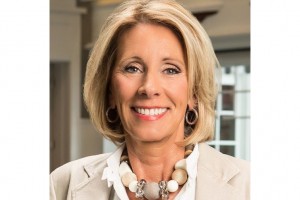4 Things You Need To Know (But Were Too Scared To Ask) About The Ed Secretary
The nomination of Betsy DeVos as secretary of education has inspired a good deal of conversation – from qualms about her qualifications to explainers about her background to praise for her record as a bullish proponent for market-based school choice.
As a school choice advocate, DeVos’ has clear priorities – expanding state private school vouchers, education tax credits and charter schools – but how much impact does the Secretary of Education have on individual state policies?
Let’s take a look at the U.S. Secretary of Education job to find out.
1. What does the U.S. Secretary of Education do?
The Secretary of Education is a dual role. As head of the U.S. Department of Education, the secretary advises the department, and proposes and executes legislation that deals with federal influence over education policy.
The secretary is also a member of the president’s cabinet. In that capacity, the secretary is the lead adviser to the President on federal policies, programs and activities related to education in the United States.
And, interestingly, the secretary of education is 15th in line of succession to the president.
2. How much influence do they have over individual states’ education policy?
Education is primarily a state and local responsibility in the United States. Less than 9 percent of the money spent on education comes from the federal government.
But the U.S. Department of Education and the Secretary of Education can make requests and offer the states guidance, regulations and additional grants for local education. And, as they write, the department “works hard to get a big bang for its taxpayer-provided bucks.”
That’s where those guidance and regulations come in – the department can attach strict stipulations on what they expect to see in return for that money. That was one of the most controversial aspects of President Barack Obama administration’s Race to the Top grants, a series of grants created to spur education innovation and reforms in states and local districts.
In return for those federal grants, the administration asked for specific things, including the adoption of common standards, school turnaround initiatives, tying tests to teacher evaluations and charter school expansion. They were controversial. Critics said the federal government overstepped its bounds by enticing states to adopt certain measures. Supporters say it helped spark a wave of reform across the country.
The department also oversees civil rights matters in education – it can pull funding from districts if it identifies discrimination based on race, disability, sexual orientation, income or gender identity.
3. Can the Secretary of Education make policy?
No.
Instead, they’re in charge of implementing and overseeing laws. Laws written by Congress and signed by the president.
A clear example of this is the new federal education law, the Every Student Succeeds Act. Congress passed it as a rewrite to No Child Left Behind. It was then signed into law by President Obama.
Now, the education department is in charge of enacting that law and overseeing implementation.
4. So, can Trump’s pick actually privatize U.S. schools?
It’s highly unlikely. There are a number of factors at play.
Remember, less than 9 percent of spending on public K-12 schools comes from the federal government. All of that money is already earmarked for specific groups of children, like students with disabilities and students from low-income families.
So, where will the money for President-elect Trump’s $20 billion school choice proposal actually come from? Well, it’s still a question.
The education department could offer grants that ask for school choice expansion, in return. It could be similar to the Obama administration’s Race to the Top grants. But getting the $20 billion into a budget passed by Congress may be very hard.
Trump’s plan also asks states to pledge another $110 billion to school choice. That may be infeasible, Kevin Carey explains in the New York Times.
States don’t have that kind of money lying around. The only plausible source is existing school funding. But even if Ms. DeVos were to find a willing governor and state legislature, it’s not that easy. Roughly half of all nonfederal education funding comes from local property taxes raised by over 13,000 local school districts. They and their elected representatives will have a say, too.
This is where the intersection of geography and politics makes any national voucher plan much more difficult to enact. The practicality of school choice is highly related to population density. Children need to be able to get from home to school and back again every day. In a large metropolis with public transportation, there could be dozens of schools within reasonable travel distance of most families. In a small city, town or rural area, there will be few or none.
And population density, as Americans saw in the last election, is increasingly the dividing line of the nation’s politics. A significant number of Mr. Trump’s most ardent supporters live in sparsely populated areas where school choice is logistically unlikely. At the same time, many of the municipalities where market reforms are theoretically much easier to put in voted overwhelmingly against the president-elect.
